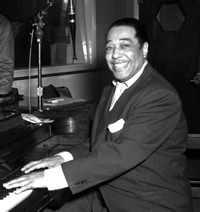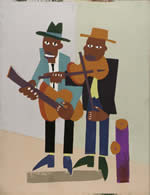Allegro
Local 802 at the time of the Harlem Renaissance
Volume 115, No. 2February, 2015

Duke Ellington (1899-1974) joined Local 802 in 1924.
In the 1920’s, a sort of pluralism sprang up within Local 802. Unlike other smaller AFM locals, Local 802 exhibited a great degree of tolerance to internal division. Within Local 802, a baffling array of ethnic interests and groups coexisted more or less peacefully. Irish musicians maintained an Irish organization. Jewish musicians maintained a Jewish organization. Flutists maintained a flutists’ organization. Pluralism and division was the rule, not the exception, in Local 802. Ethnic minorities or instrumental minorities could retain their own identities and voice their own concerns and, at once, belong to the union.
So it was with black musicians. Membership in Local 802 never spelled the end of independent black music organizations. Deacon Johnson, a former bandleader, took it upon himself to provide jobs for black musicians. He operated and heavily advertised a “clearing house for entertainers, orchestras, singers and players” in upper Manhattan. The Clef Club (see next story in this issue) and the New Amsterdam Musical Association remained in existence and continued to provide bookings, a social forum and tenuous job protection for black musicians. The New Amsterdam Musical Association also shifted its exclusionary policies, and by the mid-1920s it accepted and supported jazz musicians as much as classical musicians. Like other ethnic group organizations, these independent black organizations contributed to membership in Local 802. The Clef Club, which remained operational throughout the 1920s, preached full loyalty to the union. In August 1924, one A. Fennar, in charge of the booking office of the Clef Club, reported to the Governing Board. “All of the instrumentalists [of the Clef Club],” he said, “are members of the Local. Should any non-members enroll they are instructed to become members of the Local.…the members of the Clef Club are fully acquainted with the laws governing the same, and that the members of the Clef Club do not perform with non-members.” Fennar’s statement and appearance revealed that independent black organizations actually served to increase union membership and loyalty. Black musicians who wanted to maintain a separate black commitment could do so. Black musicians could retain control over whatever segments of the business remained in their hands through independent black organizations. But, because of Local 802’s structure of ethnic pluralism, they also became members of the integrated union and pushed the local to take action on their behalf.
In September 1926, Henry Minton, a saxophone player, became the first black delegate to the union. He immediately alerted the board to black musicians scabbing from Philadelphia and sent a letter the next week stating he “would do his utmost to secure good results.” In part, Minton may have been motivated by personal ambition and financial considerations. As sergeant-at-arms, he dictated where musicians could play and opened up an avenue for illicit contracting. But more likely, Minton genuinely was determined to support black musicians from within their union. Years later, he opened Minton’s Playhouse to serve as a meeting place and practice location for younger jazz musicians, and, from all accounts, he seemed genuinely concerned with their well being. Minton, remembered the writer Ralph Ellison, “was generous with loans, was fond of food himself and, as an old acquaintance recalled, ‘loved to put a pot on the range’ to share with unemployed friends.”

“Street Musicians” by the Harlem Renaissance painter William H. Johnson (1901-1970)
Soon, black musicians appeared more frequently at the local’s headquarters. Most often they were called up for violations of union bylaws, for owing money to the board or for employing non-union players. In 1927, the board reprimanded Fletcher Henderson, Duke Ellington and Chick Webb, for example, for failing to file weekly reports and fined each five dollars. But even reprimanding African American musicians represented an improvement. Most musicians, white or black, came before the union board for violations of its provisions, and so the very interest that the union indicated in relation to black musicians’ work demonstrated a viable interest on their behalf. By the late 1920s, black musicians had become a visible, if not politically powerful group within the union.
In the 1920s, New York’s African American musicians actualized the ideals of the Harlem Renaissance. When they played blues, jazz, and Broadway musicals, New York black musicians asserted the merits of African American culture. They gained white and black audiences, made their music formal, and became professionals. By playing long-term jobs, they joined Local 802 and maintained an ethnic identity. In all, black musicians in the 1920s changed the meaning of professional music. They made black vernacular music into popular music and professional music. They overcame some of the stratification that had limited their numbers in the 1910s and became an important group in Local 802. By drawing on black culture, musicians made political strides.
The 1920s, then, marked the pivotal moment when black musicians became central players in the New York music industry. But the union itself remained only a marginally effective body. When musicians faced a real crisis with the onset of the Great Depression, members would find their union entirely ineffective. They would need to create a more cohesive and functional body. They would need to make it more democratic. When insurrection developed in the union after 1929, black musicians had positioned themselves at the center of union politics and as possible leaders.
This article was condensed and edited from a thesis written by Jacob Goldberg for Amherst College in 2008. The thesis is available as a book for purchase at www.Lulu.com. Allegro will publish the next installment of this story in a future issue.
